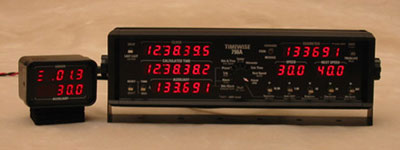RallyTech: Computer
Feb
2004
Some of the technically inclined may be interested in all the equipment we use in the cars to stay on perfect time. Both the BMW and the WRX use the same equipment in this quest.

Rally Computer
For the competitive TSD (Time-Speed-Distance) sections which will be scored on our accuracy, we’ll be concentrating entirely on the official route instructions and our Timewise 798A rally computer . The Timewise allows us to approach staying on perfect time by taking a signal from an odometer input, using the target speed (What we call the CAST — an acronym for Change Average Speed To) and displays our error between perfect time and actual time at any point during a scored section. It’s slightly complicated to learn and use if you’re unfamiliar with the goal of TSD rallying, but it really does a great job when it’s handled correctly. Basically it does a tremendous number of those good old time/speed/distance math problems you may recall from junior high school and displays those calculations in a way that is useful feedback for the driver and navigator. We each get our own display — the driver has a small box in front of him that displays the error, while the navigator gets all of that and more to control.
The Timewise can use two odometer inputs. We’ve installed connections for both in the WRX. The stock odometer in the dash is not precise enough or accurate enough for our pursuit of the perfect time. Most stock odometers read anywhere between 2-10% faster/longer than actual distance traveled — stock speedometers have a similar error. The WRX’s primary odometer sensor is a Hall Effect sensor mounted on a bracket attached to the rear differential and two magnets epoxied to the axle. As the axle turns, the magnets are exposed to the sensor which generates an electronic pulse that is relayed to the computer. The backup odo sensor is the stock VSS (Vehicle Speed Sensor) which provides the signal from the transmission to a variety of devices, including the stock odo. The BMW uses Hall effect sensors as well, one on each of the front drive axles. The Timewise allows us to tweak our odo readings to match whatever the rallymaster’s odometer used to measure the rally. It can get a little more complicated, with different tweaks for different kinds of road surfaces and tires, but I won’t go into that, mostly because I’m not good enough with the computer yet. It can be incredibly accurate. As for precision, the Timewise is able to display to a resolution of 0.001 miles. Usually rallys are measured and calculated to a hundredth of a mile. That extra digit allows for incredible precision if we’re using the equipment correctly.
As the navigator, it’s important to understand how to use the rally computer so that the driver gets good information as to whether he’s on time, early or late. If we don’t do everything correctly, including remembering to zero the odometer (see the Last (real) Practice blog entry) it means we aren’t starting with data that the computer requires. If we miss hitting the CAST switch at just the right location in the mileage, the calculations will be wrong, and the computer won’t display the error correctly, meaning that it’s impossible for it to tell us if we’re on time or not. During a scored section we need to pay attention to the official mileage in the route instructions and figure out if our odometer is displaying different numbers. If there’s a mismatch (usually due to wheel slip in gravel or on snow), we need to be able to correct both the odometer and the calculated time. The Timewise makes much of this easy, but we need to be quick and efficient in its operation. Also, we need to slap the driver’s hand if he reaches over and tries to fiddle with any of the switches.
And the driver? All he has to do is look at his display and go faster or slower.



